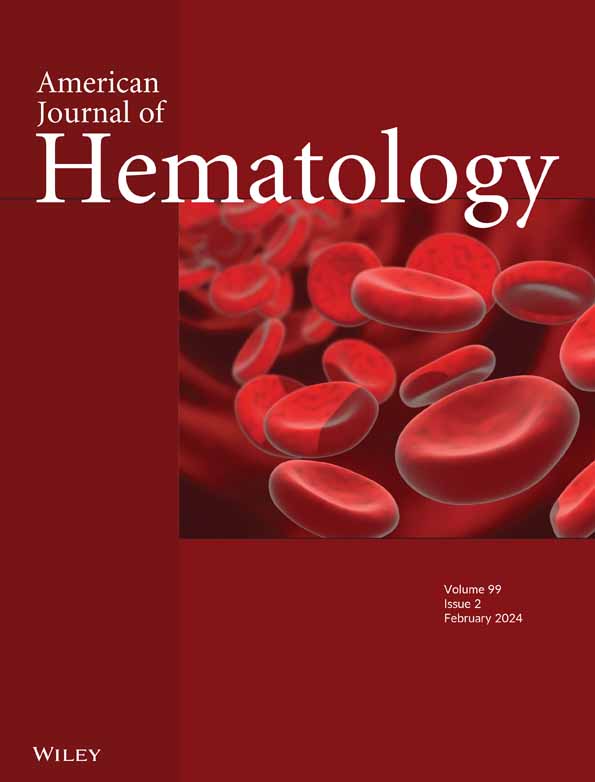异基因造血干细胞移植治疗青少年和青年急性淋巴细胞白血病:回顾性双中心研究
IF 9.9
1区 医学
Q1 HEMATOLOGY
引用次数: 0
摘要
在现代一线治疗和最小残留病(MRD)指导策略的指导下,患有急性淋巴细胞白血病(ALL)的青少年和年轻成人(AYAs)的生存结局有所改善。因此,异基因造血细胞移植(HCT)在首次缓解(CR1)中越来越多地被推迟,并用于复发的情况。然而,在AYAs中,第二次缓解(CR2)的HCT结果数据仍然有限。我们对2010年至2022年间在CR2接受HCT的15-40岁AYA患者进行了一项双中心回顾性研究。164例患者中位年龄为25岁;66%为男性,80%为b型all。一线治疗包括儿科启发(54%)和基于hypervad(33%)的方案。大多数患者接受了清髓调节(74%),HCT显示67%为mrd阴性。在中位随访36个月时,3年总生存率(OS)和无进展生存率(PFS)分别为53%和46%。3年累计复发率和非复发死亡率分别为36%和18%。6个月2-4级急性移植物抗宿主病(GVHD)发生率为36%,3-4级发生率为14%。慢性GVHD发生率为27%,其中37%为中度,25%为重度。在多变量分析中,hct特异性合并症指数>; 3与较差的OS、PFS和较高的非复发死亡率独立相关。MRD阳性预测更差的PFS和更高的复发风险,但不预测OS。这些发现支持在CR2中进行HCT作为AYA合并ALL患者的治疗选择。结果受MRD状态和合并症的影响,强调需要适应风险的移植策略。本文章由计算机程序翻译,如有差异,请以英文原文为准。
Allogeneic Hematopoietic Stem Cell Transplantation in Adolescents and Young Adults With Acute Lymphoblastic Leukemia—A Retrospective, Dual-Center Study
Survival outcomes for adolescents and young adults (AYAs) with acute lymphoblastic leukemia (ALL) have improved with modern frontline therapies and minimal residual disease (MRD)-guided strategies. As a result, allogeneic hematopoietic cell transplantation (HCT) is increasingly deferred in first remission (CR1) and used in the relapsed setting. However, data on HCT outcomes in second remission (CR2) remain limited in AYAs. We conducted a dual-center retrospective study of AYA patients aged 15–40 years who underwent HCT in CR2 between 2010 and 2022. Among 164 patients, the median age was 25 years; 66% were male and 80% had B-ALL. Frontline therapies included pediatric-inspired (54%) and hyperCVAD-based (33%) regimens. Most received myeloablative conditioning (74%), and 67% were MRD-negative at HCT. At a median follow-up of 36 months, 3-year overall survival (OS) and progression-free survival (PFS) were 53% and 46%. The 3-year cumulative incidences of relapse and non-relapse mortality were 36% and 18%, respectively. The 6-month incidence of grade 2–4 acute graft-versus-host disease (GVHD) was 36%, and grade 3–4 was 14%. Chronic GVHD occurred in 27% at 3 years, with 37% moderate and 25% severe. On multivariable analysis, a HCT-specific comorbidity index > 3 was independently associated with inferior OS, PFS, and higher non-relapse mortality. MRD positivity predicted worse PFS and higher relapse risk but not OS. These findings support HCT in CR2 as a curative option for AYA patients with ALL. Outcomes are influenced by MRD status and comorbidities, underscoring the need for risk-adapted transplant strategies.
求助全文
通过发布文献求助,成功后即可免费获取论文全文。
去求助
来源期刊
CiteScore
15.70
自引率
3.90%
发文量
363
审稿时长
3-6 weeks
期刊介绍:
The American Journal of Hematology offers extensive coverage of experimental and clinical aspects of blood diseases in humans and animal models. The journal publishes original contributions in both non-malignant and malignant hematological diseases, encompassing clinical and basic studies in areas such as hemostasis, thrombosis, immunology, blood banking, and stem cell biology. Clinical translational reports highlighting innovative therapeutic approaches for the diagnosis and treatment of hematological diseases are actively encouraged.The American Journal of Hematology features regular original laboratory and clinical research articles, brief research reports, critical reviews, images in hematology, as well as letters and correspondence.

 求助内容:
求助内容: 应助结果提醒方式:
应助结果提醒方式:


